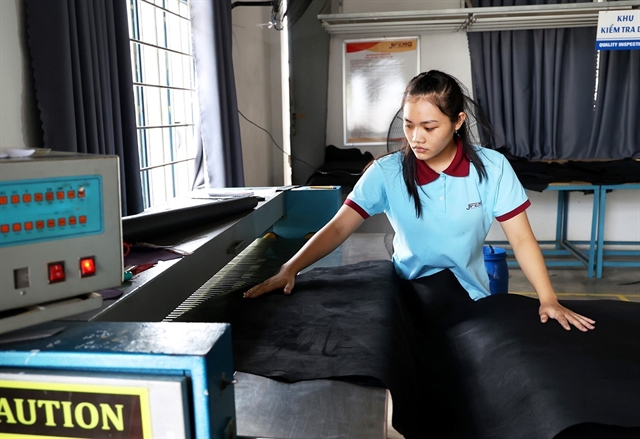 Economy
Economy

 |
| Raw materials for the leather and footwear factories produced in Bình Dương Province. Việt Nam is discussing the establishment of a centre of raw materials for textile and footwear industries to meet with green requirements and increase competitiveness. — VNA/VNS Photo Hồng Đạt |
Việt Nam is discussing the establishment of a centre for raw materials to support the textile, leather and footwear industries, signalling a bold effort for the billion-US-dollar sectors to enhance sustainability and climb higher up the global value chain.
According to the latest updates from the General Statistics Office, leather and footwear exports totalled US$17.67 billion in the first eight months of this year, or a rise of around 10 per cent over the same period last year.
The Việt Nam Leather, Footwear and Handbag Association (Lefaso) reported an export value of $15.2 billion from January to July. Of this, footwear exports reached $12.8 billion, up 10.1 per cent, while handbag exports rose to $2.35 billion, up 7.9 per cent year-on-year.
“The leather footwear industry has been gradually recovering since the end of 2023, with clear improvements in recent months,” Phan Thị Thanh Xuân, deputy president and general secretary of Lefaso, said.
Many enterprises in the industry have secured contracts until the end of 2024, and the sector is expected to reach a total export value target of $27 billion for the year.
However, the Ministry of Industry and Trade (MoIT) said that despite the sector's significant contribution to Việt Nam’s total export earnings, the added value of domestic producers remained limited. This was primarily because Việt Nam mainly engaged in contract manufacturing and relied heavily on raw materials imported from China, South Korea, and ASEAN countries.
Statistics from the General Department of Customs show that Việt Nam spent $13.42 billion importing raw materials for the garment and footwear industries in the first half of this year, up 14.11 per cent year-on-year.
“The heavy dependence on imported raw materials could negatively affect the overall development of the industry, especially as many countries push for net zero emissions by 2050 and impose stricter import requirements,” Xuân said. This emphasised the need for a domestic raw materials centre to boost the local procurement rate, she added.
Xuân further highlighted the industry's challenge in meeting new demands from importing countries, focusing on sustainability in production and social responsibility.
“Previously, sustainability was encouraged by customers, but now it is being enforced by policies in major importing countries,” Xuân said.
For example, since March, the EU — Việt Nam's second-largest importer of leather and footwear products — had introduced policies related to ecological requirements, traceability, supply chain transparency, and carbon emissions.
"While these policies aim to improve quality and promote circular economy principles, they pose significant challenges for producers throughout the supply chain," Xuân said.
As the world’s second-largest exporter of leather and footwear, Việt Nam must urgently enhance its supply chain, from raw materials to sustainable production, with a focus on circular economy practices and social and environmental responsibility.
Gerwin Leppink from the Worldwide Responsible Accredited Production (WRAP) programme noted that expanding export to markets like the US and EU required compliance with regulations, particularly those focused on sustainability, which are impacting both importers and producers.
Việt Nam’s leather and footwear industry is identified as a key export sector, with a goal of reaching an export value of $38-40 billion by 2030, according to the industry’s development strategy approved in late 2022. The strategy also aims to develop the industry sustainably following the circular economy model by 2035, improving the domestic value chain, and integrating further into the global value chain.
However, the global trend toward greening industries is putting pressure on leather and footwear production, which is still regarded as a polluting sector, according to Lefaso’s President Nguyễn Đức Thuấn.
For Việt Nam, which accounts for 7.3 per cent of the global market, second only to China, this presents both significant opportunities and challenges.
"The application of automation, artificial intelligence, and green transition is essential for companies that want to stay competitive and climb higher in the global value chain," Thuấn said.
How to ensure success
 |
| A visitor at a recent exhibition on leather and footwear industries held by Lefaco in HCM City. VNA/VNS Photo Mỹ Phương |
The proposal to establish a raw materials centre for the garment and footwear industries was a hot topic at a recent meeting of MoIT.
Trương Văn Cẩm, deputy president and general secretary of the Việt Nam Textile and Apparel Association, said that the idea had been raised several times before, but successful models had yet to be realised.
Past attempts to develop such centres in Hà Nội and HCM City in 2004 failed due to various reasons, including lack of support and coordination among relevant stakeholders.
Cẩm emphasised that the key to success lay in mechanisms and support from the government, as well as close coordination between ministries and local authorities.
Trương Thị Thuý Liên, deputy president of the Bình Dương Province Leather, Footwear and Handbag Association, pointed out that contract manufacturing, which dominates the industry, made it difficult for suppliers to engage in domestic raw material centres.
Phạm Tuấn Anh, deputy director of the Industry Department at MoIT, said the ministry was working with industry associations to finalise plans for the centre, learning from the experiences of other countries to ensure success.
“We should have built suchlike centre long ago, but for various reasons, it hasn’t happened. We need to act immediately so that the centre can be operational by 2025,” Deputy Minister of Industry and Trade Phan Thị Thắng said.
The centre would not only support the domestic industry but also help Việt Nam reduce its dependence on imported materials, ensuring compliance with stricter environmental regulations, she added.
The centre marks a bold step towards sustainability and enhancing the competitiveness of Việt Nam’s leather and footwear industry. It is expected to be funded by the private sector and will serve as a hub for both domestic and foreign suppliers, ensuring traceability, quality, and the latest developments in the fashion industry. VNS




